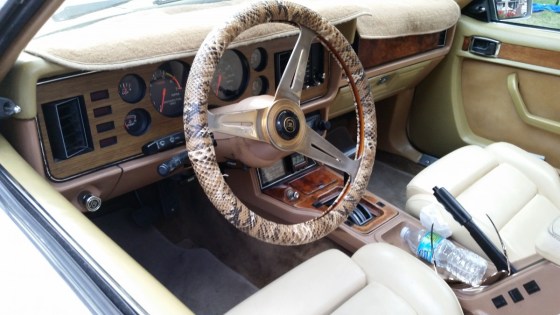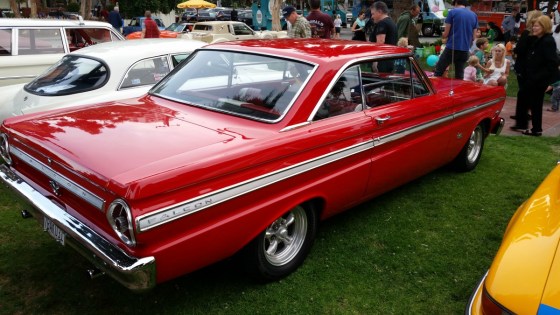Greetings laddies and lassies! I apologize for this update being a wee bit late, but here’s part two of the classic car show I stumbled on to during St. Paddy’s Day. In our first installment, we took a tour of some of Europe’s finest. In this edition, we return to the good old U.S.A. So cook up some bangers and mash, pour yourself an ice cold Guinness, and enjoy!
Our first car in this feature is part 1’s cover car- a 1984 Zimmer. For those unfamiliar with the brand, Zimmer is one of several automotive aftermarket coachbuilders that take existing late-model vehicles and transform them into neoclassics, installing faux prewar bodywork over the car’s existing underpinnings. Two other noteworthy vehicles from this category are the Excalibur and the Clenet’. Zimmer has done an admirable job of disguising this car’s Mustang DNA, but to a savvy gearhead, that door sticks out like a sore thumb 🙂 .
This car’s humble Fox-platform roots become even more apparent when peering inside. The first thing you spot is the same dash that countless malaise-era Mustang, Capri, Fairmont, and Zephyr drivers have looked over. Partially hidden behind the steering wheel is that unmistakable Ford automatic shifter that they used in everything for nearly two decades. Still, it looks super-clean and rather comfy in there- as long as you aren’t the one stuffed into the back seat. Dig the funky snakeskin steering wheel cover.
The sign up front listed this car as a V8 model, so I’m assuming it has the 4-barrel 302 from the Mustang GT. Anything less engine-wise, in this car, would be a travesty.
Next up is this neat-o ’64 Ford Falcon two-door hardtop. The shimmering red paint and tasteful, right-sized aftermarket wheels really highlight this car’s attractive lines.
The car’s interior, looking as sharp as the outside. It has the period-correct riveted wood steering wheel ( as found in the Shelby and GT Mustangs ), and you can just make out the white Hurst cue-ball shift knob, indicating a manual transmission.
I have no idea what’s underhood, but if the manual transmission, dual exhausts, and column-mounted tach are any indication, this sleek red bird probably really flies.
This 65 / 66 fastback Mustang is the Falcon’s sexier fraternal twin. The red paint, white interior, and dark grey 5-spoke rims make this car really pop. I have no idea whether this is a genuine Shelby or a clone. Doesn’t matter- it’s a righteous ride either way.
This one appears to have the standard interior rather than the deluxe “Pony” package that was available. It also sports standard instrumentation rather than the Rally-Pac. It’s still nice, although I couldn’t picture a car this sporty with a plain instrument panel. It just doesn’t seem quite right.
One of my personal favorites was this disco ‘Vette. The urethane bumpers, flat rear window, and flying buttress roofline denote it as a ’74-’77 model. The owner appears to have sourced a set of very rare cast aluminum turbine-spoke wheels from the ’82 Commemorative Edition. Just barely visible is the updated 80-82 rear bumper cap, retrofitted to this car. But the important stuff is under the hood and inside…
The L-82 was Chevrolet’s premium performance small-block during the 70’s, producing 220 horseower compared to the base L-48’s pitiful 160 ponies. That number might seem laughable today, but in real-world driving conditions, 220 horses is still respectable, especially considering how undercammed, undercarbureted, and poorly tuned most post-OPEC embargo vehicles were. Ford’s legendary Fox-platorm 5.0 Mustang didn’t make 220 horses until 1987. Even my 2001 Ford Crown Victoria, in civilian-spec trim, only made 200 horses from it’s overhead cam, multiport-injected 4.6 liter modular motor. GM was always a step ahead in the horsepower game, even during Detroit’s darkest days.
A view of the inside. This one appears to have the Vega / Camaro-style padded four-spoke wheel rather then the brushed aluminum three-spoke more common to this vintage of Vette. I believe this style of wheel wasn’t used until the 1978 refresh. Someone correct me if I’m wrong.
This partially fuzzy view through the passenger-side window show’s this car’s other highly desirable feature- the four-speed manual transmission. L-82, four speed- if you were shopping for a new Corvette during the mid-70’s, and you actually cared as much about performance as image, this was the one to have.
Another slick addition is these mirrored glass t-tops. They might cook your scalp on a balmy summer day, but at least you’ll look cool. C3 Corvettes don’t get a lot of love in many quarters, and I’ll be the first to admit that they’re far from perfect. As a regular transportation device they’re highly flawed, but as a statement, or as a functioning work of automotive art, they excel. That’s why I own one.
I was totally diggin’ this ’68 Camaro RS. The black vinyl roof, pale yellow paint, blacked out grille with hideaway headlights, and plain steel wheels shod with dog dish hubcaps and blackwall tires make it look both classy and mean at the same time, sort of like The Incredible Hulk wearing a finely tailored three-piece suit.
The Camaro’s interior, looking super-clean and entirely original. One thing I find odd is the fact that despite the fancier seat upholstery and full console, it still has the most basic instrumentation. Weren’t RSes equipped with a woodgrain instrument panel and full gauges?
The view from the rear. Many folks have criticized the 67 / 8 Camaros’ rear end as being too “plain”. I think it looks just fine and blends well with the rest of the car’s lines. The wider rear tires indicate something potent under the hood, unless the owner was simply going for a subtle hot rod look. I’d be happy to have this car, and leave it just like it is.
A brief revisit of this nifty ’63 Ford Falcon two-door wagon, which I originally covered during CC Wagon Week. This show is where I found it.
We’ll end our journey with a visit to the king of the GM A-Bodies, this 1970 Chevelle SS454. In 1970, GM finally pulled out all the stops and installed its biggest, most powerful engines in its intermediate-sized models. The hottest Chevelle SS454 model was the LS-6. Its 11:1 compression, solid-lifter, Holley-carbed 454 banged out 450 horsepower. The LS-6 could take on all comers, even Mopar’s mighty Hemi. I have no idea whether this one is the LS-6 or the tamer LS-5, but who cares? Any 454 Chevelle is better than none.
Despite the inferior quality of the materials used, I’ve always felt that early 70’s GM A-bodies had the most comfy and inviting interiors of all of Detroit’s offerings in that size / weight class, striking just the right balance of luxury and sportiness. Compare this interior with the innards of a Plymouth Satellite, Ford Torino, or AMC Matador of the same year, and tell me which one you’d rather sit in for the long drive to Vegas or Tahoe.
Well friends, it’s been fun, but I really must go. I’ve got a cold pint and a hot lass waitin’ for me. ‘Tis not wise to keep either waitin’.










































Love the Falcons and the Mustang. Not so keen on the Camaro’s colour scheme though
Neoclassics have never worked for me, their proportions vs. ’30s originals are all wrong, being based on modern chassis. The Zimmer in particular looks like a grafted Dr. Frankenstein perversion?, far worse than Excaliburs. They should’ve at least used a BOF platform.
I like Fox dashes, they were unpretentious & functional, except for the smallish glove compartment. BTW, in my experience, dashboards don’t need those carpet covers even in the Sunbelt☀, so long as a shade is used while parking outside. And no Armor-All™, either.
Remember the Bradley GT? It was a Vette-like fiberglass body on a VW chassis.
I do, thanks to their ads in PopSci; at least the Bradley wasn’t trying to look retro, and it was better than those poor butchered Beetles missing their nose & engine cover. I wish they’d either leave it as Ferdinand styled it, do an artful customization, or replace the whole body.
Love the Camaro…I’ve never been a bling/ graphics fan . The unmolested , interior , and the “dog dishes” make this car. While the colour scheme , is not quite my taste. It’s refreshing to see someone willing to think outside the box.
The zimmer started out life as a mercury cougar, I believe, hence the formal roofline. There was a dinapoli which began life as a buick regal.
The red Falcon coupe looks just right. Right size, great proportions, probably a great runner too. while I like the early Falcon this has got a lot more pop going on. The fastback Mustang and early Camaro are great also but commonly seen in shows. That Disco Vette looks pretty good but I have never been a big fan, don’t know why.
Agree, the C3 ‘Vette always seemed overdone to me, like a tart wearing too much makeup.
Zimmers and Clenets never pulled off the neoclassical thing as well as did Excaliburs. The Excalibur may still have been gaudy and easy to pick out from a “real” classic, but at least they used unique bodywork the whole way through rather than grafting neoclassic nose and tail onto a Cougar/Crown Vic/Regal/whathaveyou midsection. Any of them will certainly get you noticed though…
I always think of high school when I see a ’70 Chevelle SS. One of those was the coolest car in our high school parking lost, a red wonder with black stripes (this was in 1996-98). The guy who owned it claimed it was an original 454SS car, but that he and his dad had dropped in a later 350 because of how much gas the 454 used. The 454 was in their garage for later re-transplant when the car wasn’t his DD. He could have been blowing hot air, but the family also had a ’47 Chevy street rod in progress in their garage, so I was inclined to believe him.
That red Falcon is stunning. I always forget how good looking those cars are. Love the dart-like shape and round taillights. Great collection here!
I appraised a 65 Futura hardtop on the weekend. The car in your feature is a 1964 model. There are differences in the side trim/spear and front grille. About the only really obvious changes between the two years.
As far as I know, Full instrumentation was an SS option on the Camaro. The RS was an appearance option, though I’m sure one could be specified with more gauges. Chevy was pretty stingy with gauges back then.